The process of shedding is called ecdysis.
As a bearded dragon ages their skin does not stretch. This means they must shed their old skin for new skin.
To first time keepers shedding can sound strange. But, it is a natural and healthy behavior.
The amount of times a bearded dragon sheds depends on many factors. The most common are diet, wear-and-tear, habitat, temperature and growth rate.
If you want to learn more about why Bearded Dragons shed, how long the process lasts and what you can do to help, then keep reading!
Why Do Bearded Dragons Shed?
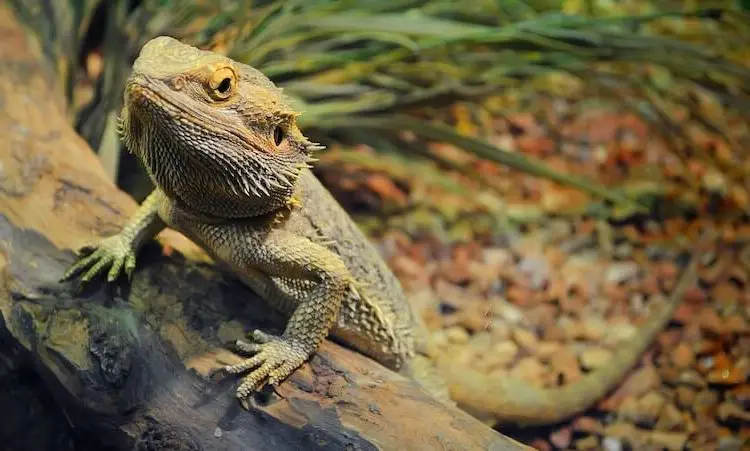
The scientific name for shedding is ecdysis.
A bearded dragon’s skin is rough and is largely made up of keratinized scales. This keratin protein is not elastic so as a bearded dragon ages its skin will not stretch.
This means when a dragon gets larger their skin stays the same size. They must shed it in order to continue growing.
As humans we are constantly shedding cells. With reptiles this entire process is done at once.
They typically sheds their outer coat.
This reveals an inner layer of skin that has already grown and is shiny in appearance.
Bearded dragon shedding typically consists of flaking in various areas rather than shedding in a single piece (e.g. like a snake would shed).
The skin generally comes off in large pieces that your beardie will tear off with their mouth. It is normal for them to eat the skin and it is a unique characteristic of this species.
It is not uncommon to see several large pieces of skin in their habitat during this process.
This process is not painful for your dragon and he will do all the work himself.
Bearded Dragon Shedding Process
The shedding process varies depending on age and environment. During each lifestage your lizard will shed at different speeds over different durations.
Hatchlings shed differently from Juveniles who are different from adults.
How Often Do Bearded Dragons Shed?
Bearded dragon hatchlings shed the most frequently.
Hatchlings shed nearly every week. This happens because the hatchling is growing at 1 to 3″ per month and needs to replace their skin quickly. If your hatchling is shedding less frequently this is okay. But if they are not shedding at all you should take them to the vet.
The older they get the less they shed:
| Age | Shedding Frequency | Why |
|---|---|---|
| Hatchling (0 to 6 months) |
1 to 2 weeks | Hatchlings constantly outgrown their skin because of their growth rate. |
| Juvenile (6 to 18 months) |
6 to 8 weeks | Juveniles still growing quickly but will not outgrow their skin as often as a hatchlings. |
| Adult (18 months +) |
1 to 2 times a year | Due to constant wear-and-tear. |
Juveniles shed less than hatchlings and it is normally every six to eight weeks.
A six-month-old juvenile will shed once every four to six weeks. A twelve-month-old juvenile will shed once every few months.
As your Bearded Dragon starts to age he will shed less frequently.
Adults shed just a few times each year. This change from juvenile to adult typically occurs around eighteen months of age.
There are a variety of factors that influence shedding in adults so it is often unpredictable. Adults are known to shed once or twice a year.
How Long Does It Take For A Bearded Dragon To Shed?
The general rule of thumb is the older a bearded dragon is the longer their shed takes.
As hatchlings and juveniles shedding only last a week.
They both shed at a much higher rate than adults. It is necessary for them to complete their shed before starting another:
- A hatchling’s shed lasts for about 1-3 days.
- A juvenile’s shed can last a week or two.
- An adult’s shed can take up to three weeks.
Once your dragon reaches their senior years it can take up to three weeks to shed.
At three weeks into the process an adult should be finishing up.
If after three weeks an adult still has considerable portions left to shed there could be stuck shed.
Bearded Dragon Shedding Behavior
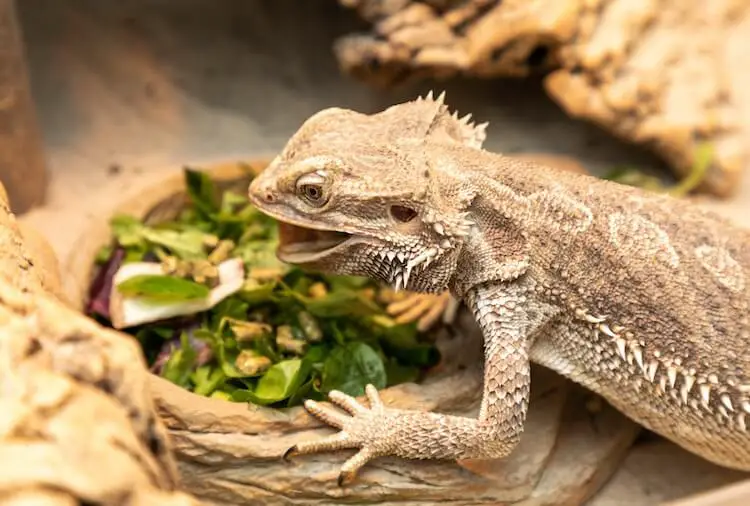
As bearded dragons shed there are four subtle behavioral changes to look for.
These behaviors are completely normal and should not be anything to worry about. Signs of shedding include a change of:
- Skin Color.
- Diet.
- Appearance (e.g. Eye Bulging).
- Behavior.
When your Bearded Dragon is about to shed their appearance will darken.
Patches of loose, grey skin will begin to detach. The older skin will be dull and grey. The portions of new skin will be glossy and bright.
It is not uncommon for Bearded Dragons to experience a loss of appetite when shedding.
A refusal to eat before or after the process is normal too. Bearded Dragons usually do not eat during this time as they eat their own shed.
In the wild food is often scarce and hard to find. As an evolutionary mechanism this species historically ate their old shed to preserve nutrients lost from shedding.
If a bearded dragon loses its appetite and shows no other signs of illness, then it is most likely due to shedding. You should continue to offer food.
Another behavior to observe is eye bulging.
In many reptiles eye bulging is a form of communication. However eye bulging in Bearded Dragons is a common sign of shedding. Their eyes may appear dull and whitish blue too.
Bulging eyes help loosen the skin around their head and eyes.
Excessive eye bulging outside of shedding can be a sign of high blood pressure or atrioventricular block.
Bearded dragons may also exhibit skittish behavior when shedding. Common behaviors include: rubbing up against a rock, branch or hard surface and eating shed skin.
Why Is My Bearded Dragon Lethargic?
It is normal for a bearded dragon to show signs of lethargy when shedding.
This is because shedding requires a significant amount of energy. Removing old skin requires them to rub up against various surfaces in order to peel it off.
He will be less active in his enclosure a few days before and after his shed.
Why Is My Bearded Dragon Irritable When Shedding?
Shedding is not the most pleasant experience for Bearded Dragons. It can cause them to feel itchy and irritable.
The amount of energy lost from shedding can also be stressful for them.
During this time it is a good idea to avoid handling.
How To Help A Shedding Bearded Dragon
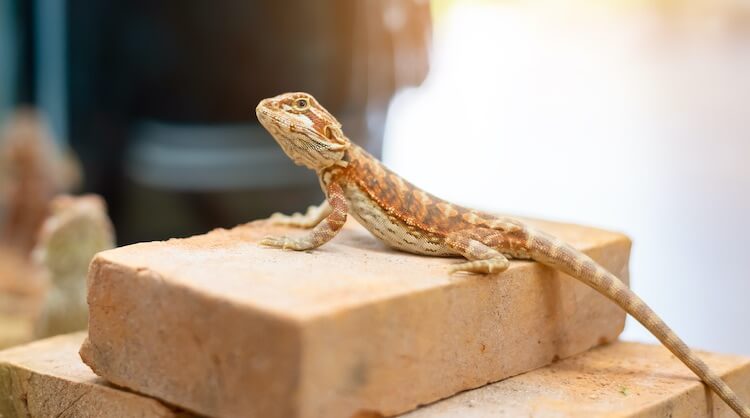
Proper habitat and setup is the best thing you can provide to help. Correct husbandry and habitat setup are things you should be doing regardless of their shed.
There are three things you can also do to help them shed:
- Place rough materials in their environment.
- Check UVB lighting.
- Provide nutrient supplements.
1. Put Rough Materials In Their Enclosure
When a bearded dragon is shedding you should put rough materials in their enclosure for them to rub up against.
They rub up against rough materials to remove or loosen pieces of skin.
These materials should not be too sharp but should be strong enough to aid the skin removal process.
In the wild Bearded Dragons use branches and rocks to help snag their dead skin. Good materials to use include:
- Branches.
- Rocks.
- Slates.
- Substrate (e.g. reptile carpet).
Besides branches and rocks you can also place triangular shaped hides.
2. Diet and Water
If your bearded dragon is not receiving a proper diet it can cause serious health issues and not just affect shedding.
Without the right amount of calcium in their diet they can suffer from metabolic bone disease.
A calcium supplement with vitamin D3 should be added to an adult’s diet, and the same calcium powder should be used for juveniles and hatchlings.
It is important you learn more about the specifics of a healthy bearded dragon diet and remember hydration is just as important as diet.
3. Check Terrarium Set Up
The last step you can take to make sure your Bearded Dragon has a healthy shed is to provide them with a proper terrarium (i.e. correct lighting, temperature and humidity).
In order to maintain light quality you should use a tube-shaped UVB light and replace it every six months. They should get 12 hours of light each day to mimic their natural environment.
They should also have a 40W to 75W infrared basking bulb.
Their basking temperature can start off at 95℉ to 105℉ with a cooler side around 75℉ to 80℉.
Humidity levels should be kept between 30% and 40%.
A bearded dragon is happy with the temperature of their environment if they are brightly colored and positioned upright on the basking surface.
Why Is My Bearded Dragon Not Shedding?
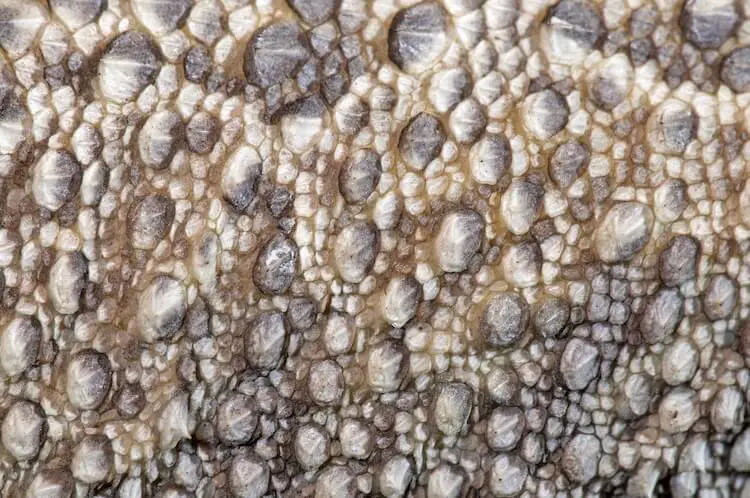
There are many reasons for why Bearded Dragon might not shed.
Many shedding issues relate to poor husbandry, malnutrition or low humidity levels:
- A poor diet.
- Lack of hydration.
- Improper UVB lighting.
- Improper environment temperature.
Difficulty in shedding is also known as dysecdysis. Dysecdysis affects 25% of pet Bearded Dragons.
Dysecdysis can be caused by underlying health issues such as parasites, tumors, ulcers and blisters. They are often caused by skin infections from not keeping their enclosure clean.
Your bearded dragon may also prematurely stop shedding because it does not have enough rough surfaces to rub up against.
You should never pull or rip off pieces of skin from your bearded dragon.
If pieces of skin are dangling it is because they are still attached to the sensitive skin that lies underneath. Pulling it off can result in injury and pain.
It is important you are patient and understand that shedding is a natural part of a bearded dragon’s life.
You should only help if he has completed shedding and you spot areas with stuck shed.
Bearded Dragon Stuck Shed: How To Help
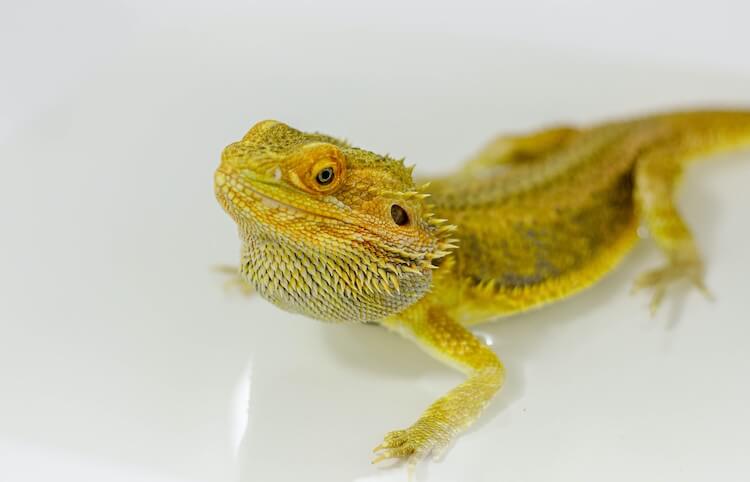
Bearded dragons can experience stuck shed when they do not have enough nutrients.
Stuck shed will usually occur on the tail, near the eyes, the underside of the belly and feet.
As Bearded Dragons age they will be more susceptible to stuck shed. Old skin that is not shed in a timely manner can lead to restricted blood flow and cause infection. It can lead to cell death in fingers and toes. Severe stuck shed in the tail can be more problematic.
If your bearded dragon is not shedding properly, or always has stuck shed, then make sure to check their temperature and humidity. Even if you do have the proper humidity levels sometimes stuck shed happens.
If your Beardie is experiencing a stuck shed there are multiple ways that you can help:
- Bathing.
- Misting.
- Shedding Aid.
- Oils.
- Check for loss of blood circulation.
Bathing
Bathing is a great first step to help the shedding process.
Fill a bowl or tupperware container with lukewarm water to the eye level of your bearded dragon. Place them in the water and make sure the area with stuck shed is submerged.
Wait for 15 minutes and never leave them unsupervised.
After the bath try gently brushing the area with a toothbrush. As adults take longer to shed it is a good idea to give them a bath every several days.
Misting
Besides bathing you can also try to mist your dragon.
Gently spray droplets of water on your Beardie’s head and body. Focus on the areas that your lizard may have trouble shedding and mist them daily.
Misting often aids the shedding process by increasing the humidity in the tank.
Shedding Aids and Oils
The last method you can use to help a stuck shed is shedding aids and oils.
Shedding aids and oils are a spray specifically made to help moisturize the stuck shed.
Only use them as a last resort to misting and bathing.
The most common areas for stuck shed are the fingers and tail tip.
Unfortunately stuck shed can go unnoticed for many months leading to necrosis. This is the main reason why it is common for bearded dragons to lose part of their fingers or tail as they age.
Make sure to always be gentle when helping a stuck shed to avoid causing pain.
Summary
You should now understand why Bearded Dragons shed and what the process involves.
Remember hatchlings shed the most frequently and shed nearly every week. Adults shed just a few times each year.
With the correct habitat and humidity your Bearded Dragon should generally be able to shed on his own.
Stuck shed can happen but this is normally nothing a bath or misting cannot fix.
Taking the proper steps to prevent stuck shed and avoiding handling is essential to help your Bearded Dragon live a long and happy life.
If this advice has helped you and your Beardie, let us know in the comments below!

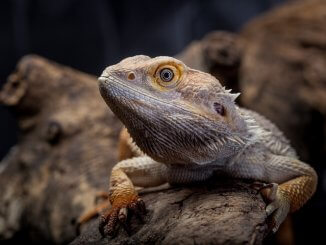
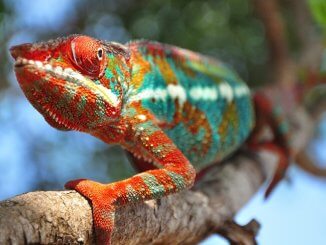
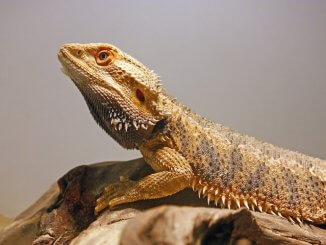

This article was brilliant. Thank you. Explained easily, in language that children can understand. Easy reading and very informative. Thank you.
My bearded dragon is about 5 months, his back is shedding, I tried the bath and toothbrush but it’s not coming off.. What should I do?
thanks i am 13 and just learing about this and it is very helpful
My biggest issue with this article is the information about lighting. An infrared bulb will hurt your dragons eyes and 3rd eye, get a ceramic heat emitter instead.
I agree that a ceramic heater is a better option, but a bearded dragon cannot see infrared lighting and, more importantly, they get lots of infrared from the sun in their natural environment. Infrared light per se is not harmful. Eyesight is more often damaged by incorrect UVB positioning.
However, it is worth mentioning that many reptile owners end up buying infrared bulbs that emit visible red light too, and this can indeed be harmful, as it can disrupt sleep and cause stress when used at night.
My daughter has a bearded dragon and has found a lump under its front leg can you advise on what she should do the bearded dragon is shedding and not eating and very lafargic do you think this is bad or good
Not eating much and being inactive during shedding is completely normal. Give him time to complete the shedding. You can help him shed by increasing humidity (some people like to mist the skin) and by providing a rough surface to grind against. Regarding the lump this could potentially be a worrying sign and I would advise a visit to the vet.